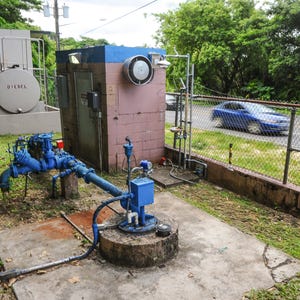The former Naval Air Station in Tiyan and 10 military sites in Guam are covered by a Pentagon-ordered study announced in March to determine the risk of contamination with the same potentially cancer-causing chemical found in some of Guam Waterworks Authority’s drinking water wells, a federal document states.
Located in the Tiyan area near the international airport, Naval Air Station was turned over to the government of Guam after the facility closed in 1995. The Tiyan area now hosts Tiyan High School, Guahan Academy Charter School, Guam Department of Education offices, and a mix of abandoned and occupied houses.
Tiyan sits above part of the northern aquifer, which is Guam’s underground source of fresh water, according to an environmental impact study for the closure of the former Naval Air Station.
The additional sites that will be tested for potential drinking water contamination fall under the Navy’s authority, but some of them are located within Andersen Air Force Base, according to the list.
U.S. EPA attached the list of military facilities covered by the risk assessment for drinking water contamination in a March 2016 letter to the Base Realignment and Closure’s Program Management Office.
The Pentagon wants the drinking water sources at 664 military sites investigated for possible perfluorinated compounds contamination because of past use of firefighting foams at military airports and crash-training sites, National Public Radio and The Associated Press reported.
Two perfluorinated compounds — perfluorooctanoic acid, or PFOA, and perfluorooctane sulfonate, or PFOS — have been found in certain GWA wells between March last year and last month.
Previous tests clear bases’ drinking water
Samples taken from nine wells providing drinking water to Naval Base Guam were tested at an EPA-approved laboratory in 2014 and again last year, and no perfluorinated chemicals were detected, said Greg Kuntz, deputy public affairs officer for Joint Region Marianas, which is the joint administrative entity for the Navy and Air Force bases in Guam.
No known or suspected perfluorinated chemical sources were identified within a mile of drinking water wells located on Andersen Air Force Base, according to Kuntz in an email.
As a precaution, environmental personnel will test again for perfluorinated compounds at production wells serving Andersen Air Force Base sometime this year, he said.
PFOS was used for water repellant, such as nonstick cooking pots and pans and airport and aircraft firefighting equipment, before U.S. regulators banned the chemical more than a decade ago.
Tests conducted for GWA's system showed the presence of either or both PFOA and PFOS in some of GWA-owned or operated wells between March last year and last month. Four water wells — two in the Tiyan area and two in Hagåtna — showed high PFOS levels that required a U.S. EPA health advisory.
While PFOS levels were high at four Guam water wells, PFOA contamination in GWA wells didn’t exceed the U.S. EPA threshold for a health advisory, the test results last year and last month show.
GWA notified the public of the water contamination on Aug. 12, more than a year after one of the four wells showed high levels of PFOS contamination.
GWA shut down the Hagåtña wells in late July, but two Tiyan wells continue to produce water because a treatment system is in place for those two wells to keep contamination out of the drinking water supply, according to GWA.
Here are the Guam sites listed in the EPA letter:
- Former Naval Air Station site 00012
- Guam Naval Activities site 00014
- Former Naval Air Station solid waste management unit site 00022
- Andersen Air Force Base site 0025A
- Andersen Air Force Base site 0026A
- Andersen Air Force Base site 0078A
- Andersen Air Force Base site 0078B
- Andersen Air Force Base site 0078C
- Andersen Air Force Base site 0078D
- Andersen Air Force Base site 0078E
- Andersen Air Force Base site 0078F



No comments:
Post a Comment